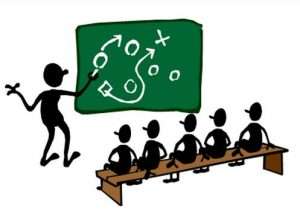Comparing the Roles of CEO and Owner

Corporate leadership is a nuanced concept that requires careful consideration of the various roles involved. Among the most critical roles in organizational leadership are those of the CEO and the owner. While these two roles overlap in some ways, they also differ significantly in their overall responsibilities and decision-making authority. This article will delve into the key differences between the roles of CEO and owner and explore how these differences impact the overall management of a company.
The Key Differences Between CEO and Owner
Before we can explore the differences between the roles of a CEO and an owner, it’s important to understand what each of these positions entails. While both roles involve leadership within a company, they have distinct responsibilities and areas of focus.
Definition of a CEO
The CEO, or Chief Executive Officer, is the highest-ranking executive in a company. This person is responsible for the overall management of the company and sets the strategic direction for the organization. The CEO typically reports to the board of directors and may have other senior executives reporting to them.
The CEO’s primary responsibility is to ensure the company’s success and profitability. To achieve this, they must make strategic decisions that align with the company’s goals and vision. They must also manage the day-to-day operations of the company, ensuring that everything runs smoothly and efficiently. This often involves overseeing various departments and teams, such as finance, marketing, and human resources.
Another important aspect of the CEO’s role is to represent the company to external stakeholders, such as investors, customers, and the media. They must communicate the company’s values, mission, and vision effectively, while also building relationships and partnerships that benefit the company.
Definition of an Owner
An owner, on the other hand, is someone who has a financial stake in a company. This person may have started the company from scratch or acquired ownership through investment. Owners typically have a say in the overall management of the company and may be involved in key strategic decisions.
Owners often have a personal connection to the company and may be more invested in its success than a CEO who is hired from outside. They may also have a more hands-on role in the day-to-day operations of the company, especially if they are a small business owner. This can involve anything from managing finances to interacting with customers and employees.
However, owners may also face unique challenges that CEOs do not. For example, they may struggle to balance their personal and professional lives, especially if they have invested a significant amount of their own money into the company. They may also face pressure to make decisions that benefit their own financial interests, rather than the company’s long-term success.
In conclusion, while both CEOs and owners play important roles in the success of a company, they have distinct responsibilities and challenges. By understanding these differences, companies can ensure that both positions are filled by individuals who are well-suited to their respective roles.
Responsibilities and Roles of CEO and owner
While the CEO and owner both play key leadership roles within a company, their specific responsibilities differ significantly. Understanding these differences is crucial for effective collaboration between these roles.
The CEO’s Role in a Company
The CEO is primarily responsible for setting the strategic direction for the company. They work with other senior executives to develop long-term plans and ensure that these plans are properly executed. The CEO also has the responsibility of communicating with the board of directors and other stakeholders, representing the company’s interests and promoting its objectives.
One of the key responsibilities of the CEO is to ensure that the company is financially stable. This involves managing budgets, forecasting revenue, and making sure that expenses are kept under control. The CEO must also make sure that the company is compliant with all relevant laws and regulations, and that it is operating ethically and responsibly.
The CEO is also responsible for building and maintaining relationships with key partners and stakeholders. This includes customers, suppliers, investors, and other organizations that the company works with. The CEO must be able to communicate effectively with these groups, understand their needs and concerns, and work to build strong and lasting relationships.
The Owner’s Role in a Company
The owner typically has a more hands-on approach to managing a company. While they may not be involved in every aspect of day-to-day operations, they have a vested interest in ensuring the company is successful, both in terms of financial performance and reputation.
Owners are often responsible for setting the company’s overall vision and mission. They may also be involved in developing the company’s brand and marketing strategy, and in making key decisions about product development and pricing.
In addition to strategic decision-making, owners may also be involved in managing day-to-day operations. This could include tasks such as hiring and firing employees, managing finances, and handling customer complaints.
Owners must also be able to build and maintain relationships with key stakeholders. This includes customers, suppliers, and investors, as well as employees and other members of the community. Owners must be able to communicate effectively with these groups, understand their needs and concerns, and work to build strong and lasting relationships.
Decision-Making Authority
One key difference between the roles of a CEO and an owner is their decision-making authority. While both have influence over the direction of the company, they approach decision-making in different ways.
CEO’s Decision-Making Power
The CEO typically has the final say in most operational and strategic matters. They work with other senior executives to develop strategies and plans, but in the end, it is typically the CEO’s responsibility to make final decisions. The board of directors provides oversight, but the CEO has the day-to-day decision-making power over the company.
However, it is important to note that the CEO’s decision-making power can be limited by the company’s organizational structure. For example, in a matrix organization, decision-making power may be shared among multiple leaders. Additionally, in a company with a strong and independent board of directors, the CEO’s decision-making power may be more limited.
Furthermore, the CEO’s decision-making power can also be influenced by external factors, such as market conditions, regulatory requirements, and public opinion. In these situations, the CEO may need to collaborate with other stakeholders, such as government officials, industry experts, or community leaders, to make informed decisions that align with the company’s goals and values.
Owner’s Decision-Making Power
The owner has substantial decision-making power in that they typically have the right to veto any major decisions that may have significant impact on the company. Small Business Owners may be involved in decision-making and may lead management discussions on key decisions.
However, the owner’s decision-making power can also be limited by their own expertise and experience. For example, an owner who lacks knowledge in a particular area, such as finance or marketing, may need to rely on the advice of others to make informed decisions in those areas.
Additionally, the owner’s decision-making power can be influenced by their personal values and beliefs. For example, an owner who is passionate about environmental sustainability may prioritize eco-friendly initiatives over other business goals, even if they are less profitable in the short term.
In conclusion, while both CEOs and owners have decision-making authority, their power and influence can be shaped by a variety of internal and external factors. It is important for leaders to be aware of these factors and to collaborate with others to make informed decisions that align with the company’s goals and values.
Financial Management
Financial management is a critical area of focus for both CEOs and owners. While their specific responsibilities may differ, effective financial management is essential for the long-term success of a company.
Financial management involves the planning, organizing, directing, and controlling of a company’s financial resources. It includes budgeting, forecasting, cash flow management, financial analysis, and reporting. Effective financial management helps a company to make informed decisions, allocate resources effectively, and achieve its financial goals.
CEO’s Involvement in Financial Matters
The CEO has significant involvement in financial matters. They may work closely with the CFO or other financial executives to create and manage budgets, forecast financial results, and manage cash flow. The CEO also has the responsibility of ensuring that financial metrics are met, including revenue targets, profits, and return on investment. They are ultimately responsible for regular financial reporting to the board of directors and other stakeholders.
The CEO’s involvement in financial matters goes beyond just managing the company’s finances. They also play a critical role in setting the company’s financial strategy, including identifying potential investment opportunities, evaluating risks, and making decisions about financing options.
Additionally, the CEO must be able to communicate financial information effectively to both internal and external stakeholders. This includes presenting financial reports and analysis to the board of directors, investors, and lenders.
Owner’s Involvement in Financial Matters
The degree to which an owner is involved in financial matters varies depending on their background and experience. Some owners may work closely with the CFO to review financial performance and provide guidance on managing finances. Others may be less involved in day-to-day financial matters, but still have the final say in key decisions related to budgets and investments.
Owners who are actively involved in financial matters can provide valuable insights and guidance to the CFO and other financial executives. They can help to identify potential risks and opportunities, and provide input on financial strategy and decision-making.
Owners who are less involved in financial matters should still have a basic understanding of the company’s financial performance and goals. This can help them to make informed decisions about investments and other financial matters.
In conclusion, effective financial management is essential for the long-term success of a company. Both CEOs and owners play important roles in managing a company’s finances, and must work together to make informed decisions and achieve financial goals.
Leadership Styles
Another key difference between the roles of CEO and owner is their respective leadership styles. Understanding these styles is crucial for effective collaboration and communication within a company.
Common CEO Leadership Styles
CEOs often have different leadership styles depending on the culture and values of their company. However, common styles include the transformational leader who inspires and motivates employees, the autocratic leader who makes unilateral decisions, and the hybrid leader who blends styles depending on the situation.
Common Owner Leadership Styles
Owners may also have different leadership styles, but often lean towards more hands-on approaches. They may be visionary leaders who set broad direction for the company, or they may be more involved in day-to-day activities, providing guidance and direction to employees on particular projects.
Roles of CEO and Owner
Understanding the roles of CEO and owner is crucial for effective leadership within a company. While both positions play critical roles in the success of a company, they have distinct responsibilities and decision-making authority. By working together and leveraging their unique strengths, CEOs and owners can create a powerful leadership team that drives sustainable success.
















Leave a Reply